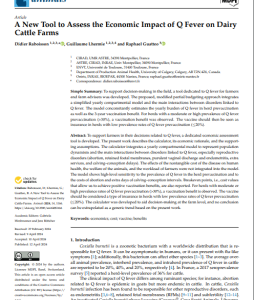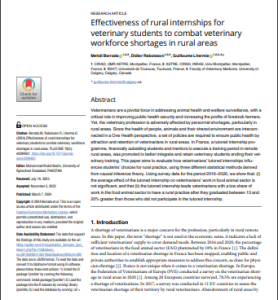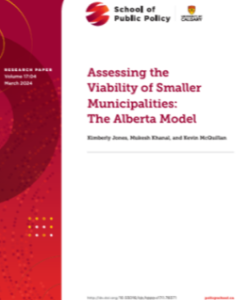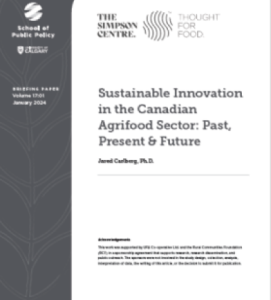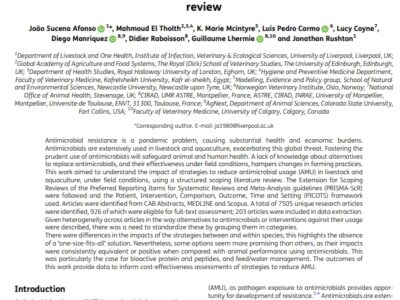Publications
To support farmers in their decisions related to Q fever, a dedicated economic assessment tool is developed. The present work describes the calculator, its economic rationale, and the supporting assumptions. The calculator integrates a yearly compartmental model to represent population dynamism and the main interactions between disorders linked to Q fever, especially reproductive disorders (abortion, retained foetal membranes, purulent vaginal discharge and endometritis, extra services, and calving–conception delays). The effects of the nontangible cost of the disease on human health, the welfare of the animals, and the workload of farmers were not integrated into the model. The model shows high-level sensitivity to the prevalence of Q fever in the herd prevaccination and to the costs of abortion and extra days of calving–conception intervals. Breakeven points, i.e., cost values that allow us to achieve positive vaccination benefits, are also reported. For herds with moderate or high prevalence rates of Q fever prevaccination (>30%), a vaccination benefit is observed. The vaccine should be considered a type of insurance in herds with low prevalence rates of Q fever prevaccination (≤20%). The calculator was developed to aid decision-making at the farm level, and no conclusion can be extrapolated as a generic trend based on the present work.
Friday, April 12, 2024
Didier Raboisson, Guillaume Lhermie, and Raphael Guatteo
We are facing interdependent challenges that call for a shift in our agri-food system. And there is one way forward: the One Health way. Transitioning our food systems is a unique opportunity to implement cross sectorial public policies. It is time to focus on the potential to preserve and restore human, animal, plant and environmental health.
Monday, March 18, 2024
Guillaume Lhermie
Veterinarians are a pivotal force in addressing animal health and welfare surveillance, with a critical role in improving public health security and increasing the profits of livestock farmers. Yet, the veterinary profession is adversely affected by personnel shortages, particularly in rural areas. Since the health of people, animals and their shared environment are interconnected in a One Health perspective, a set of policies are required to ensure public health by attraction and retention of veterinarians in rural areas. In France, a tutored internship programme, financially subsiding students and mentors to execute a training period in remote rural areas, was promoted to better integrate and retain veterinary students ending their veterinary training. This paper aims to evaluate how veterinarians’ tutored internships influences students’ choices for rural practice, using three different statistical methods derived from causal inference theory. Using survey data for the period 2016–2020, we show that: (i) the average effect of the tutored internship on veterinarians’ work in food animal sector is not significant; and that (ii) the tutored internship leads veterinarians with a low share of work in the food animal sector to have a rural practise after they graduated between 13 and 20% greater than those who did not participate in the tutored internship.
Thursday, March 07, 2024
Mehdi Berrada, Didier Raboisson & Guillaume Lhermie
Small towns, villages and rural areas in Alberta face serious fiscal challenges due to economic and social trends that have seen their populations stagnate or decline while job opportunities and young people leave for bigger cities. While other provinces have opted for sweeping reorganization to local governments, including amalgamation, annexation or the establishment of regional forms of government, Alberta has chosen a case-by-case approach to its municipalities through the use of viability reviews.
Alberta’s viability review process is an excellent way for the province to monitor and address the fiscal struggles of individual municipalities. More must now be done to fine-tune the postdissolution process so that Alberta Municipal Affairs can equitably address the governance problems that follow.
Friday, March 01, 2024
Kimberly Jones, Mukesh Khanal, and Kevin McQuillan
In order to remain globally competitive with sustainable innovations in agri-food, both the public and private sectors in Canada must increase investment in the industry.
Studies reveal that both sectors’ support for agri-food innovation has declined in recent years. To spur innovation and growth public funding should revert to previous levels, ideally reaching 0.10 per cent of GDP. Incentives such as tax relief, matching funds and enhanced protection of intellectual property rights could spur increased levels of private sector investment in innovation.
In the past 50 years, innovation in agriculture has brought tremendous benefits to producers, processors and consumers. Successful innovations include genetically modified crops, large-scale cattle feeding operations and the adoption of no-till farming, which has reduced the traditional practice of summerfallowing fields. Still, with the demand for a secure global food supply and growing concerns about the environmental impacts of large-scale farming, the need for sustainable innovation in the agri-food sector is pressing.
This paper offers three recommendations for policy-makers. First, public funding for agricultural research and development should be increased to prior levels. Next, the private sector needs more favourable conditions to foster investment in the agri-food industry. Last, if intellectual property rights are strengthened, innovating firms will be reassured that they can capture the economic benefits innovation creates.
Wednesday, January 31, 2024
Jared Carlberg
Antimicrobial resistance is a pandemic problem, causing substantial health and economic burdens. Antimicrobials are extensively used in livestock and aquaculture, exacerbating this global threat. Fostering the prudent use of antimicrobials will safeguard animal and human health. A lack of knowledge about alternatives to replace antimicrobials, and their effectiveness under field conditions, hampers changes in farming practices. This work aimed to understand the impact of strategies to reduce antimicrobial usage (AMU) in livestock and aquaculture, under field conditions, using a structured scoping literature review. The Extension for Scoping Reviews of the Preferred Reporting Items for Systematic Reviews and Meta Analysis guidelines (PRISMA-ScR) were followed and the Patient, Intervention, Comparison, Outcome, Time and Setting (PICOTS) framework used. Articles were identified from CAB Abstracts, MEDLINE and Scopus. A total of 7505 unique research articles were identified, 926 of which were eligible for full-text assessment; 203 articles were included in data extraction. Given heterogeneity across articles in the way alternatives to antimicrobials or interventions against their usage were described, there was a need to standardize these by grouping them in categories. There were differences in the impacts of the strategies between and within species; this highlights the absence of a ‘one-size-fits all’ solution. Nevertheless, some options seem more promising than others, as their impacts were consistently equivalent or positive when compared with animal performance using antimicrobials. This was particularly the case for bioactive protein and peptides, and feed/water management. The outcomes of this work provide data to inform cost-effectiveness assessments of strategies to reduce AMU.
Friday, November 10, 2023
João Sucena Afonso, Mahmoud El Tholth, Luis Pedro Carmo, Lucy Coyne, Diego Manriquez Alvarez, Didier Raboisson, Guillaume Lhermie, and Jonathan Rushton
